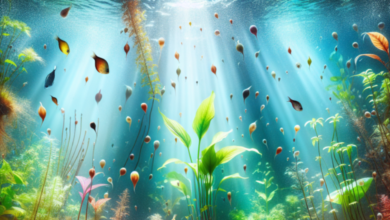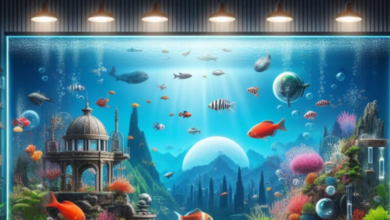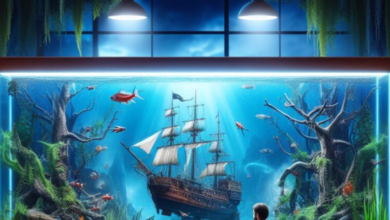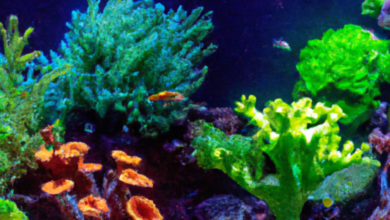In the tranquil world of Aquarium Carpet Plants, the lush carpet of greenery at the tank’s base evokes a feeling of serenity.
Aquarium hobbyists know well the transformative power these verdant carpets wield, altering a glass box into a vibrant ecosystem.
Carpet plants bridge the gap between the aquatic world and the terrestrial, crafting an underwater landscape that captivates and inspires onlookers.
Unveiling Carpet Plants
Carpet plants, akin to terrestrial groundcovers, form dense, low-growing mats that create an illusion of a miniature landscape beneath the water’s surface. Selected for their ability to proliferate, these species require specific light, nutrients, and maintenance to thrive in the aquatic tapestry they form. They are prized not only for their aesthetic appeal but also for providing essential habitat for microfauna and promoting a balanced ecosystem.
Amongst aquarists, carpet plants like Monte Carlo, Dwarf Hairgrass, and Glossostigma elatinoides are coveted for their fine-textured foliage and adaptability to diverse water parameters. These species become the foundational element in ‘Nature Aquariums,’ a philosophy introduced by Takashi Amano, which seeks to recreate natural vistas within the confines of an aquarium.
Low Light Tolerant Varieties
Cryptocoryne species are venerated for their resilience in low-light environments, boasting lush foliage with minimal illumination. These botanicals thrive where other carpet plants may falter, offering versatility in aquascaping.
Marsilea hirsuta, resembling a four-leaf clover, flourishes beautifully without intense lighting, adding a touch of verdancy to shaded corners of the aquatic scene. Its hardy nature allows for a cohesive carpet despite subdued conditions.
Staurogyne repens thrives in dimmer aquatic realms, bolstering underwater diversity.
For those tackling the challenge of a low-light aquarium, Java moss is a robust contender, adapting to varying degrees of shade with ease. Its undemanding nature ensures a green carpet will spread, enriching the habitat without straining for light.
Fast-Growing Ground Covers
When rapid coverage is essential, certain species excel, swiftly colonizing the substrate.
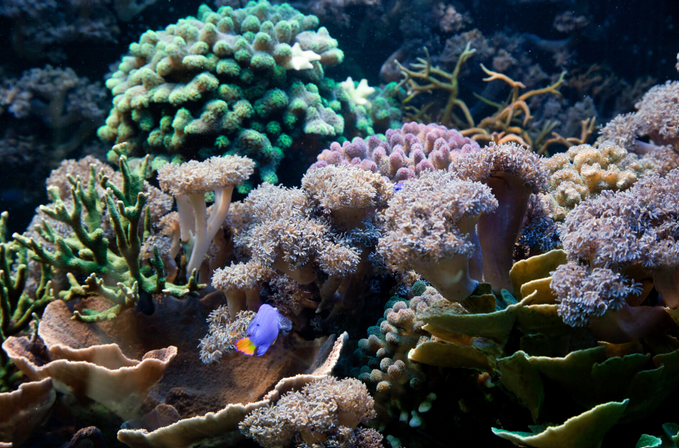
- Eleocharis parvula (Dwarf Hairgrass) is known for its quick expansion and fine texture.
- Glossostigma elatinoides establishes dense mats in favourable conditions at a brisk pace.
- Micranthemum ‘Monte Carlo’ offers a lush, blanket-like cover and is adaptable to a range of conditions.
- Sagittaria subulata proliferates rapidly, its ribbon-like leaves creating a verdant meadow.
These selections promise a verdant aquascape within a remarkably short timeline.
Adjusting light and CO2 levels can optimize their growth trajectories, ensuring vigour and resilience.
Carpet Plants for Beginners
Choosing the right carpet plant is crucial for beginners; some species are far more forgiving and require minimal technical knowledge.
- Dwarf Sagittaria (Sagittaria subulata)
- Java Moss (Taxiphyllum barbieri)
- Marimo Moss Balls (Aegagropila linnaei)
- Staurogyne repens
- Dwarf Hairgrass (Eleocharis parvula)
These species offer a balance between aesthetic appeal and ease of maintenance, perfect for those just starting their aquascaping journey.
Considerations such as lighting, substrate, and nutrient availability can greatly impact these plants’ success, but the above selections are known for their resilience and adaptability.
Start with these forgiving choices, and over time, as your skills evolve, you can experiment with more demanding species to create a truly stunning aquarium carpet.
Planting Techniques Demystified
Careful planting is critical to establish a thriving carpet in your aquarium. Amend the substrate with nutrients prior to planting to promote root development.
In order to ensure uniform coverage, individual plantlets should be spaced evenly. Proper spacing allows light and water circulation, fostering a cohesive mat formation.
Employ a delicate touch—secure plantlets without overburdening their stems. This finesse encourages successful root establishment and flourishing growth.
Preparing Your Substrate
Proper substrate preparation is pivotal for the successful establishment of carpet plants in an aquarium.
- Select a nutrient-rich substrate suited for plant growth, usually consisting of fine gravel or specialized aqua-soil.
- Rinse the substrate thoroughly to remove any dust and impurities that can cloud your water.
- Level the substrate in your aquarium, providing a gentle slope if desired for aesthetic depth.
- Consider layering with a base fertilizer or a laterite layer underneath to supply essential nutrients.
- Test and adjust the pH and hardness of your water to match the needs of your chosen carpet plants.
A consistent granule size facilitates root penetration and spreading.
Plant roots need both stability and access to nutrients—your substrate is the foundation for both.
Plant Spacing Strategies
Aquatic carpet plants require thoughtful placement to ensure their proliferative success and aesthetic appeal. Initial spacing between individual plantlets can influence their long-term growth patterns and overall health. To avoid overcrowding, which can lead to poor nutrient uptake and stifled growth, devise a spacing strategy before planting.
Many hobbyists adopt the checkerboard pattern, strategically situating plants at regular intervals in an alternating fashion. This layout facilitates light penetration and nutrient distribution, allowing for an even growth across the substrate. As they mature, the plants’ runners will interweave, filling in the gaps to create a lush, seamless carpet.
The density of planting is another consideration that hinges on the plant species’ growth rate. Fast-growing species can be spaced more generously, as they will quickly cover the substrate. Conversely, slow growers demand closer initial placement to accelerate full coverage and minimize the appearance of bare spots.
Seasoned aquarists often employ the ‘dry start method’, where plants are spaced and grown emersed before the aquarium is filled with water. This approach benefits root development and can lead to a more robust underwater plant carpet once submerged. However, patience is key—a full carpet may take several weeks to establish.
Regardless of your chosen strategy, allow adequate room for each plant to access light and nutrients without competition from its neighbors. Your foresight in spacing will be rewarded with the verdant growth of a healthy aquatic carpet.
Anchoring Plants Securely
Integral to establishing an aquatic carpet is the secure anchoring of plants within the substrate. This foundational step ensures plant stability and proper root development.
For effective anchoring, it’s essential to use a substrate conducive to plant growth—usually consisting of small, nutrient-rich grains. Gentle insertion of plant roots into the substrate, while ensuring that the delicate crown—the point where the roots meet the stem—is above the substrate surface, will promote healthy growth. Using planting tools designed for aquariums can help achieve the right balance of firm anchoring without damaging the plants. If roots are too shallow, plants may become dislodged; too deep, and they risk rotting.
Additionally, some aquarists utilize specialized plant anchors or weights to maintain plant positioning. Avoid the use of metals that may corrode or leach harmful substances into the water column. Safe materials such as lead-free weights or soft, malleable ties can be used to lightly tether plants until their roots establish a firm grip on the substrate.
Over time, as plants develop their root systems, they become more self-sufficient and less reliant on artificial aids. Natural interlocking of roots creates a stable matrix that anchors the carpet securely to the aquarium floor. Continuous assessment of plant stability is crucial, particularly after maintenance activities or if you notice sections of the carpet rising. Persistent issues may indicate the need to reassess your anchoring techniques or to introduce modifications to encourage stronger anchorage.
Optimizing Growth Conditions
To enhance carpet plant vitality, lighting is paramount—aiming for the optimal lux conducive to photosynthesis without encouraging excessive algae growth. Moderating light levels stimulates uniform carpet development and deters patches of die-off.

For nutrient absorption, employing a high-quality aquatic substrate rich in essential minerals aids in bolstering root systems. Incorporating CO2 injection can expedite growth, but balance is key—over-saturation may harm your aquatic fauna. Gradual adjustments allow acclimation and prevent stress-induced decline.
Consistent water parameters, such as stable pH and temperature, steer carpet plants towards robust growth. These metrics require regular monitoring to sustain an environment where your aquatic greenery thrives.
Essential Nutrients & Fertilization
Aquatic plants demand specific nutrient profiles.
For luxuriant carpet plant growth, essential macronutrients and micronutrients must be readily available. A comprehensive fertilization regimen should address nitrogen (N), phosphorus (P), potassium (K), iron (Fe), and manganese (Mn), among other elements. These serve as building blocks for cellular structure and function. Further, the availability of these nutrients can profoundly influence not just the health, but also the coloration and density of the carpet.
Micronutrients play a pivot role as well.
For potent growth, CO2 supplementation is critical. CO2 acts as a catalyst, driving the photosynthetic machinery within plants. Aquariums often lack the natural CO2 influx found in outdoor environments; thus, introducing a CO2 system can dramatically elevate carpet plant vitality. However, caution is advised, as too much CO2 can shift pH levels detrimentally.
Balancing nutrients and CO2 is crucial.
The introduction of fertilizers should be calculated and methodical. Advanced aquarists will meticulously track nutrient levels, adjusting dosages to promote optimal health without inducing algae outbreaks. The advent of specialized liquid fertilizers and substrate additives has simplified this process, allowing even novice enthusiasts to maintain horticultural equilibrium within their aquatic biomes.
Ideal Lighting for Vibrant Carpets
Lighting is the lifeblood of any thriving aquatic carpet ecosystem, serving as a pivotal factor for photosynthesis. The intensity, spectrum, and duration of light all play crucial roles in dictating the health and vibrancy of your aquarium’s plant life. High-output LED systems are popular for carpet plants due to their ability to deliver a full spectrum of light.
When optimizing lighting for carpet plants, one should consider the photosynthetically active radiation (PAR) values that these plants require. Typically, carpet species like Hemianthus callitrichoides or Dwarf hairgrass thrive with PAR levels that replicate moderate to high natural sunlight conditions. Utilizing lights with PAR ratings conducive to plant growth is essential for developing a rich, verdant carpet.
In addition to PAR, the spectrum of light is significant, with plants generally responding best to full-spectrum lighting. Light at the cooler end of the spectrum (6500K to 7000K) is ideal, supporting lush, compact growth and vibrant green hues in carpet species. Lighting with proper color temperature encourages not only growth but also the manifestation of full pigmentation.
Establishing a consistent photoperiod is critical; too little light can lead to etiolation, whereas too much can provoke algae proliferation. A balanced photoperiod of 8 to 12 hours daily simulates a natural environment, fostering steady photosynthesis without overwhelming the system. Smart lighting systems with programmable timers can automate this process, ensuring optimal light cycles.
Lastly, it is pertinent to periodically evaluate and adjust your lighting setup as your aquatic garden matures. Growth stages and plant densities can alter light penetration, necessitating adjustments to maintain the delicate balance within your aquarium. Regular assessments guarantee the enduring success of your underwater landscape.
Water Parameters to Monitor
Aquatic plants, much like terrestrial ones, demand specific water conditions for optimal growth. The pH level, a measure of the water’s acidity or alkalinity, should typically be kept within a range of 6.0 to 7.5 for most carpet plants, ensuring they can efficiently absorb nutrients.
Total dissolved solids (TDS) also play an essential role; these are the total concentration of substances dissolved in the water. Carpet plants thrive when TDS levels are minimal, as high concentrations can inhibit growth and lead to leaf degradation or discoloration.
Temperature regulation is paramount for maintaining a stable environment. While carpet plants usually prefer temperatures between 72°F to 78°F, some species require more specific conditions. Thus, it’s important to match the plant’s natural habitat to maintain its health and visual appeal.
When considering water hardness, both general hardness (GH) and carbonate hardness (KH) levels should be evaluated—GH for the concentration of divalent ions and KH for the water’s buffering capacity against pH changes. Levels that are too high or too low can stress plants and hinder their growth.
Moreover, tracking nutrient levels, specifically nitrates, phosphates, and essential elements like iron and potassium, is critical for the sustenance of carpet plants. These should be delicately balanced, as excesses or deficiencies can lead to poor growth and vitality.
Maintenance and Care Hacks
To safeguard the lush verdure of your aquatic carpet, a regular grooming routine is indispensable. Trimming overgrowth not only preserves the aesthetic of your aquascape but prevents detritus from accumulating amongst the foliage—averting the risk of algae blooms that thrive in such debris.
Introduce a regimented schedule to replenish nutrients in the substrate and water column, crafting a hospitable ecological niche for your plants. Utilize specialized tools like substrate spades and liquid dispensers to distribute fertilizers homogeneously, ensuring that all areas of your carpet receive the nutrition they need. Observing the plants’ response to these inputs allows for fine-tuning of your care strategy, optimizing their growth and vibrancy.
Regular Trimming Practices
Effective carpet plant care in an aquarium necessitates high-precision trimming to maintain their compact, lush appearance. Ignoring this step can lead to unruly growth patterns.
Scheduled trimming sessions foster dense growth, enabling carpet plants to form a uniform mat across the aquarium’s substrate. These sessions should be methodical, avoiding overzealous cuts that may stress the plants.
Utilizing sharp, specialized aquascaping scissors can enhance the trimming process, ensuring clean cuts that promote healthy regrowth. Precision tools are crucial for intricate work among delicate flora.
Trimming is not solely for aesthetic purposes—it plays a vital role in maintaining plant health, as well. Removing older, light-blocking leaves allows for better water flow and light penetration, supporting new growth.
Regular, thoughtful trimming will keep your aquatic carpet verdant and vibrant, aiding in the overall equilibrium of your aquarium’s ecosystem. +#+#+#+Adeptness in this regime is key for its success.
Algae Control Measures
Algae proliferation can overshadow the beauty of a well-maintained aquarium carpet. Effective control strategies are necessary to preserve the health and aesthetics of submerged flora.
To preemptively combat algae, introduce fast-growing plants as part of a balanced plant community. These species outcompete algae for nutrients and light, significantly reducing the likelihood of excessive algae. Regular maintenance routines, including water changes and substrate cleaning, limit the nutrients available for algal blooms. Furthermore, ensuring optimal plant growth conditions through adequate lighting, CO2 supplementation, and nutrient dosing can prevent algae from gaining a foothold.
Biological reinforcements, such as algae-eating organisms, are a natural and effective means of control. Stocking your aquarium with shrimp, snails, or certain fish species can help manage minor algae outbreaks, maintaining the appeal of your carpet plants without resorting to harsh chemical treatments.
Lastly, vigilant monitoring and swift action are paramount when dealing with inevitable algae occurrences. Isolating affected areas and manually removing visible algae prevent its spread. In cases where physical removal is insufficient, targeted treatments using algaecides must be considered with care, as overuse can disrupt the delicate balance within the aquarium, potentially harming both flora and fauna. Thus, an integrated approach combining preventive, manual, and biological methods constitutes the most effective strategy for maintaining an algae-free carpet.
Managing Plant Health
Aquatic plant vitality hinges on establishing and maintaining a finely tuned environment.
- Regulate Lighting: Balance intensity and duration to align with plant species requirements.
- Optimize Nutrient Supply: Ensure the availability of essential macro and micro-nutrients.
- Maintain Water Quality: Regular water changes and filtration keep parameters stable.
- Monitor CO2 Levels: Adjust CO2 injection to meet photosynthetic demands without promoting algae growth.
- Implement Algae Control: Introduce algae-eating fauna and remove algae manually when detected.
Consistency in care is the cornerstone of lush, healthy carpet plants.
Proper trimming practices not only cultivate the desired aesthetic but also encourage robust growth and propagation.

